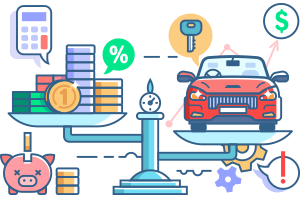As the country recovered from The Great Recession, the auto industry led the industrial-sector back to best-ever sales numbers in 2017. Part of its resurgence was due to a shift to longer-termed auto loans, by consumers whose incomes levels were not tracking industry growth, sought to purchase advanced new models albeit with lower monthly payments. In 2017, the auto industry itself began contracting even while the long-term auto loan industry continued to churn along. The recently released Quarterly Consumer Credit Trends report by the Consumer Financial Protection Bureau (CFPB) details how those long-term loans are faring in the payback stage, and what those circumstances might mean for the economy as a whole.
America = Automobiles
America’s immense love of cars has fueled one of the strongest industrial comebacks since The Great Recession. By 2013, the auto industry had reached its pre-Recession peak of 15.6 million units; and 2016 saw its best year ever, reaching a total of 17.55 units. It was the seventh straight year of rising auto sales, which marks an unprecedented streak for the automobile industry within the American economy.
A willingness by lenders to extend car loan terms from an average of 60 months to as many as 84 months has fueled at least part of the industry’s growth. CFPB statistics reveal how the industry has changed in the eight years since the end of the recession:
- Loans of six years or longer are now standard for the majority of car loans, which accounted for only 26 percent of all auto loans in 2009 but account for a full 42 percent of loans through mid-2017.
- Further analysis reveals that the credit scores of those longer-term borrowers are 39 points lower than the average five-year borrower, which indicates that people who have shakier financial foundations are also seeking longer terms over which to purchase their new car.
- The loan amounts also have changed to reflect the credit reality of the borrower. Longer-term loans are used now to obtain more expensive cars, with a six-year term value averaging $25,300, while a five-year term averages just $20,100. And loans for seven or more years averaged a value of $32,200.
Therefore, as of mid-2017, the average auto loan borrower had a lower credit score but was given a longer term to repay a higher debt.
Assessing the Value of Long-term Auto Loans
Not all experts are convinced that the auto loan trend is a positive one for consumers. One calculation indicates that borrowers actually pay more in total for their vehicles than they would if they’d taken out a shorter term loan.
Because longer-term loans generally have lower monthly payments, many consumers take on the bigger debt because they can afford the smaller monthly payment. They may not, however, be able to afford the higher debt. As loan amounts grew by 16 percent from 2009 to 2016, the average loan payment grew by only 7 percent; consumers are taking out bigger loans, but not increasing their payment value to match the higher debt level. Consequently, consumers end up paying substantially more for the vehicle than they would have if they’d assumed a shorter-term loan at the same interest rate. For example, after three years, the borrower of a five-year loan of $20,000 at 5 percent would have paid $2,190 in interest and have a remaining balance of $8,602. Conversely, after those same three years, the borrower of a six-year loan at 5 percent interest would have paid $2,342 in interest and have a more than $10,000 balance remaining.
The Data Confirms the Concerns
Furthermore, the higher debt over a longer term also adds years of stress on the already challenged borrower. Statistics indicate that borrowers of six-year loans are more likely to default on their loan and that existing defaults (more than 90 days in delinquency) are higher for loans with six or more year terms. Worse: defaults for both five- and six-year terms are rising at a comparable rate.
Predicting the Future of Auto Loan Debt with Today’s Data
Unfortunately, the auto industry’s willingness to facilitate loans to “sub-prime” borrowers (those with lower credit scores) may also be creating the same type of “bubble” that took down the housing industry in 2007. To date, the U.S. auto loan debt stands at over $1 trillion, and that burden is certain to suppress spending in the coming years. Coupled with the already-rising default rate, the debt load may be capable of causing the same level of economic damage that the housing industry crashed caused just 10 years ago.
Unsurprisingly, the 2017 numbers appear to support that theory:
- Both auto prices and interest rates have been rising in the intervening years, chilling the willingness of consumers to continue to buy.
- To remain competitive, many manufacturers increased their incentive offers, which reached an industry high of $4,000 per vehicle in November 2017. The deals, however, also decreased manufacturer’s profit levels; and to quell those costs, many reduced productions as the year wore on (which could eventually reduce job numbers, too). Auto lenders also offered additional payment options to make it easier for consumers to satisfy their loan terms.
- Previously leased cars are showing up on used-car lots, which expands the inventory volume, making new cars less attractive than lightly-used, “pre-owned” cars.
The CFPB’s data indicate that the American auto industry is now over the peak of its post-Recession boom and those previously eager car buyers may be regretting assuming more debt so shortly after the recovery began. As inventory grows and loans default, automakers will be forced to either reduce production or increase incentives, both of which will cut into their profits and productivity, which will, in turn, cut into America’s economy.











